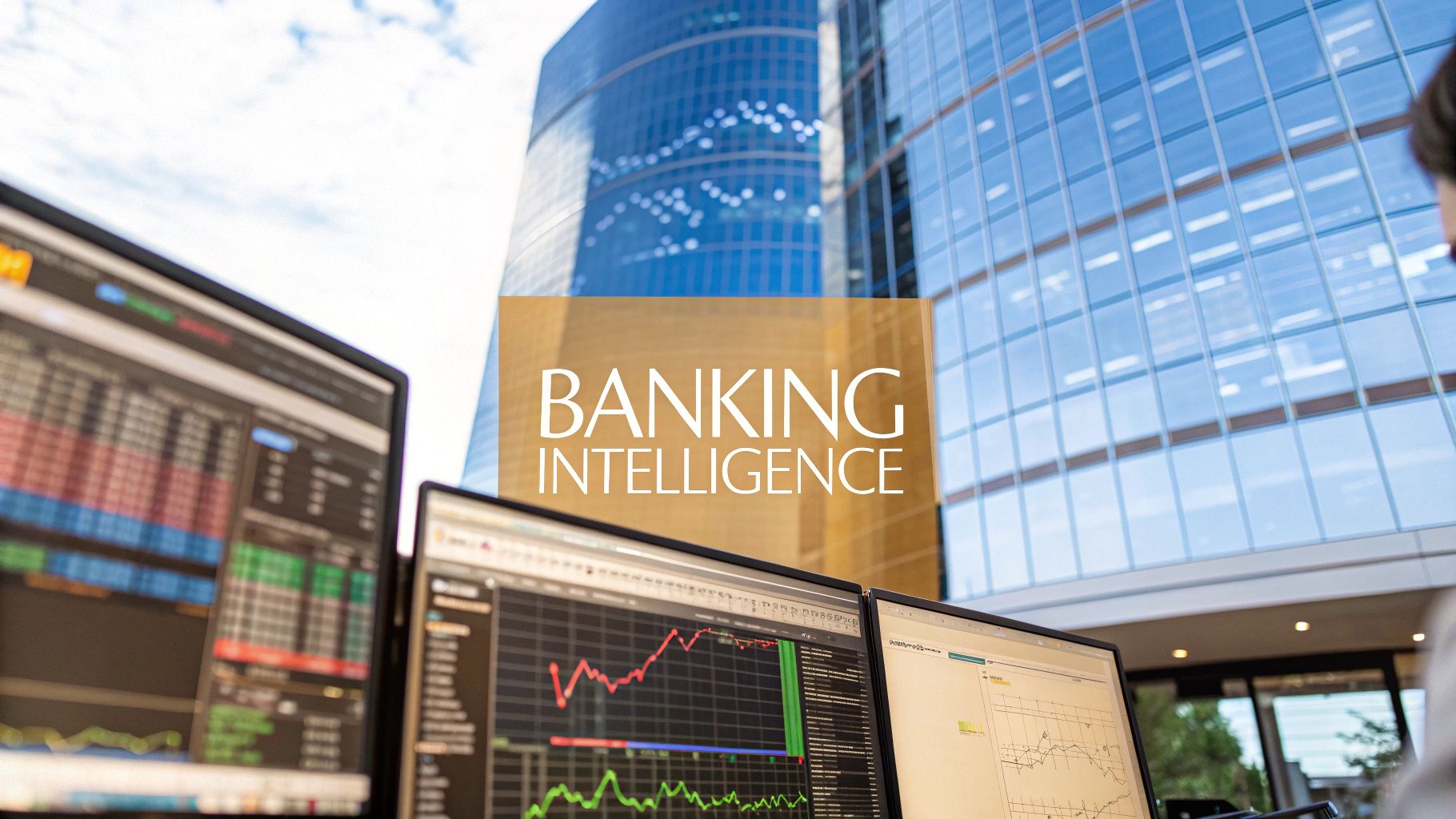← Back to News
Revolutionizing Banking with Intelligence and Action: The Power of BIAS
Banking Knowledge Base3/25/2025Banking Knowledge Basebanking intelligenceBanking Intelligence and Action System

Banking Intelligence Revolution
- BIAS Transforms Banking: The Bank Intelligence and Action System (BIAS) represents a revolutionary approach to banking analytics, integrating advanced data processing, AI, and real-time monitoring.
- Data-Driven Decision Making: Modern banks leverage big data analytics to enhance operational efficiency, improve risk management, and gain competitive advantages in a digital marketplace.
- Performance Optimization: BIAS enables financial institutions to track key performance indicators, identify trends, and respond to market changes instantly, providing actionable insights for continuous improvement.
- Advanced Technology Integration: Modern banking intelligence systems use AI and machine learning algorithms to process complex financial data, offering customizable solutions for diverse banking needs.
- Strategic Implementation: Successful BIAS adoption requires comprehensive assessment, strategic planning, infrastructure integration, and ongoing staff training.
- Tangible Benefits: Banks implementing advanced intelligence systems have reported significant improvements, including 30% operational efficiency gains and 40% reduction in risk exposure.
- Future-Ready Banking: Continuous innovation and adaptable technology investments are crucial for banks to remain competitive in an increasingly digital financial landscape.
Table of Contents
- Understanding BIAS: The Next Evolution in Banking Intelligence
- Why Data-Driven Decision Making is Reshaping Banking
- How Does BIAS Transform Financial Institution Performance?
- Essential Features of Modern Banking Intelligence Systems
- Implementing BIAS: A Strategic Approach for Banks
- Real-World Applications of Banking Intelligence Systems
- Future-Proofing Your Bank with Advanced Analytics
Understanding BIAS: The Next Evolution in Banking Intelligence
The Bank Intelligence and Action System (BIAS) represents a revolutionary approach to banking analytics and operational intelligence. This comprehensive platform integrates advanced data analytics, artificial intelligence, and real-time monitoring capabilities to transform how financial institutions operate and make decisions. By combining multiple data sources and advanced analytics, BIAS provides banks with actionable insights that drive performance improvement and competitive advantage. The system's core components include real-time data processing, predictive analytics, and automated reporting functions that seamlessly integrate with existing banking infrastructure. This integration enables banks to leverage their current technological investments while advancing their analytical capabilities.Why Data-Driven Decision Making is Reshaping Banking
The evolution of banking analytics has fundamentally transformed how financial institutions approach decision-making. Modern banks leverage big data analytics to enhance operational efficiency, improve risk management, and gain competitive advantages in an increasingly digital marketplace. This shift towards data-driven banking decisions has become essential for survival in today's competitive landscape. By implementing sophisticated analytics tools, banks can process vast amounts of transaction data, customer behavior patterns, and market trends to make informed decisions. This approach has led to significant improvements in risk assessment, fraud detection, and customer service delivery. Learn more about our pricing options for accessing these powerful analytics tools.How Does BIAS Transform Financial Institution Performance?
BIAS revolutionizes financial institution performance through its comprehensive suite of real-time monitoring capabilities and predictive analytics features. The system enables banks to track key performance indicators, identify trends, and respond to market changes instantly. Performance optimization tools within BIAS help institutions identify operational inefficiencies and implement corrective measures proactively. The platform's ROI measurement metrics provide clear visibility into the impact of strategic decisions, allowing banks to adjust their approaches based on concrete data. This real-time banking insights capability ensures that institutions can maintain competitive advantage while optimizing their operations continuously.Essential Features of Modern Banking Intelligence Systems
Modern banking intelligence systems incorporate sophisticated AI and machine learning algorithms that continuously learn and adapt to new patterns and challenges. These systems feature advanced data visualization capabilities that make complex financial data accessible and actionable for decision-makers at all levels. The integration of AI-powered banking intelligence ensures that institutions can process and analyze vast amounts of data efficiently. Automated reporting functions streamline compliance processes and provide stakeholders with timely, accurate information. The system's customization options allow banks to tailor the platform to their specific needs and objectives, ensuring maximum utility and return on investment.Implementing BIAS: A Strategic Approach for Banks
Successful BIAS implementation requires a carefully planned strategic approach. The process begins with a comprehensive assessment of current systems and capabilities, followed by detailed planning for integration with existing infrastructure. This strategic approach ensures minimal disruption to ongoing operations while maximizing the benefits of the new system. Staff training plays a crucial role in successful implementation, with comprehensive programs designed to ensure all users can effectively utilize the system's capabilities. Best practices for adoption include phased implementation, regular feedback collection, and continuous optimization of processes.Real-World Applications of Banking Intelligence Systems
Banks implementing BIAS have reported significant improvements in operational efficiency and customer service delivery. Case studies demonstrate substantial cost reductions through automated processes and improved decision-making capabilities. Success stories include regional banks achieving 30% improvements in operational efficiency and major institutions reducing risk exposure by 40% through enhanced predictive analytics. Customer experience enhancements have led to increased satisfaction rates and improved retention, while operational streamlining has resulted in significant cost savings across various banking functions.Future-Proofing Your Bank with Advanced Analytics
The future of banking intelligence lies in scalable, adaptive systems that can evolve with changing market demands. Emerging trends in banking intelligence point toward increased automation, enhanced predictive capabilities, and more sophisticated customer insights. Banks must consider scalability in their technology investments to ensure long-term viability and competitive advantage. Innovation opportunities continue to emerge as technology advances, offering banks new ways to leverage data for competitive positioning. Institutions that embrace these advances position themselves for sustained success in an increasingly digital banking landscape.Frequently Asked Questions
- What is BIAS in banking?
- BIAS (Bank Intelligence and Action System) is an advanced analytics platform that integrates artificial intelligence, real-time data processing, and predictive analytics to help financial institutions make data-driven decisions, optimize performance, and gain competitive advantages.
- How does banking intelligence improve operational efficiency?
- Banking intelligence systems improve operational efficiency by automating complex processes, providing real-time insights, enabling predictive analytics, reducing manual work, identifying operational inefficiencies, and allowing banks to make proactive strategic decisions based on comprehensive data analysis.
- What are the key benefits of implementing a banking intelligence system?
- Key benefits include enhanced risk management, improved customer service, cost reduction, faster decision-making, advanced fraud detection, personalized customer experiences, compliance streamlining, and the ability to adapt quickly to market changes.
- How can banks successfully implement a banking intelligence system?
- Successful implementation involves comprehensive system assessment, strategic integration planning, minimal operational disruption, staff training programs, phased rollout, continuous feedback collection, and ongoing optimization of processes and technologies.
- What technologies power modern banking intelligence systems?
- Modern banking intelligence systems are powered by advanced technologies including artificial intelligence, machine learning algorithms, big data analytics, real-time data processing, automated reporting tools, and sophisticated data visualization capabilities.
- How do banking intelligence systems improve risk management?
- These systems improve risk management by analyzing vast amounts of transaction data, detecting unusual patterns, providing predictive risk assessments, enabling real-time monitoring of potential threats, and offering comprehensive insights into potential financial risks.
- What is the future of banking intelligence?
- The future of banking intelligence involves increasingly scalable and adaptive systems with enhanced automation, more sophisticated predictive capabilities, deeper customer insights, and continuous technological innovation to meet evolving market demands.
Similar Articles

Brian's Banking Blog
Key Trends in the Banking Industry for Bank Executives

Brian's Banking Blog
The Executive Guide to Personalized Banking Service

Brian's Banking Blog
What Is Market Intelligence? A Guide for Bank Executives

Brian's Banking Blog
What Is Competitive Intelligence in Banking?

Brian's Banking Blog
Mastering Commercial Banking Relationship Management: A Data-Driven Executive Guide

Brian's Banking Blog
Uniform Bank Performance Reports: A Strategic Guide for Bank Executives

Brian's Banking Blog
What Is Business Intelligence Analytics for Banking?

Brian's Banking Blog
10 Customer Onboarding Best Practices for Banks in 2025

Brian's Banking Blog
A Guide to Performance Measurement Systems for Bank Executives

Brian's Banking Blog